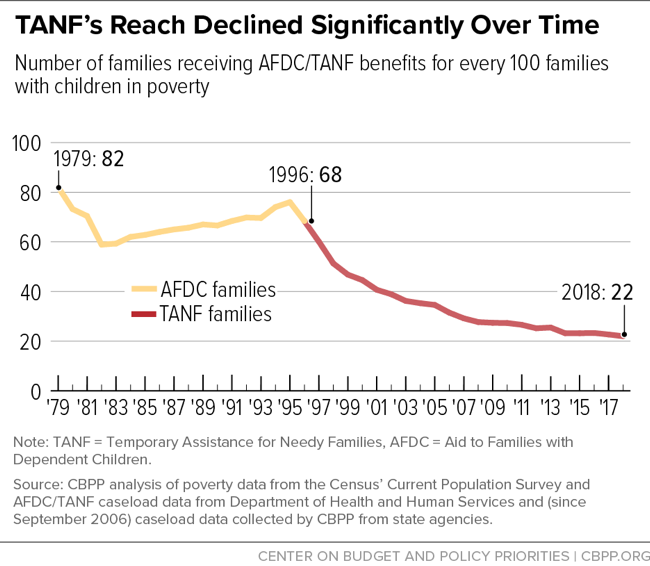BEYOND THE NUMBERS
The share of children of color living in deep poverty (below half the poverty line) rose in the decade after a 1996 law created the Temporary Assistance for Needy Families (TANF) block grant and weakened other anti-poverty programs, my colleagues have found. TANF, which replaced Aid to Families with Dependent Children (AFDC), has deteriorated since then, as we’ve detailed in recent papers on TANF’s spending, benefit levels, and reach to families in poverty. State and federal policymakers can ensure that TANF does more to support children in deep poverty.
Deep poverty rose among children between 1995 and 2005 mainly due to the loss of cash assistance for millions of families under TANF policies that take cash assistance away from those who don’t meet a work requirement, impose strict time limits, and impose barriers that prevent families from accessing the program. Our three latest TANF papers detail the program’s poor performance.
- TANF’s reach has fallen to the lowest point in its history. For every 100 families with children living in poverty in 2018, only 22 families received TANF. That’s about a third of the 68 in 100 families that AFDC reached in 1996, its last year (see chart). Generally, this “TANF-to-poverty ratio” has dropped over time because the number of families that TANF is serving has fallen more than the number of families living in poverty. There’s wide variation among states, but TANF has all but disappeared in a growing number of them. In 2018, 16 states provided TANF to just 10 or fewer families for every 100 living in poverty, while no state had that same low rate in 1996.
- States are raising TANF benefits, but they still leave families in deep poverty. Some 17 states and the District of Columbia have increased cash assistance to families since 2017. For five of them, it was the first time in over a decade. Nevertheless, benefit levels in almost every state remain quite low. Eighteen states’ monthly benefits are below $356, or 20 percent of the federal poverty line. Benefits have also lost considerable value in most states, declining by at least 20 percent since 1996 in inflation-adjusted terms in 33 states.
- Collectively, states are spending a smaller share of their federal and state TANF funds on direct assistance to families. States spend only about a fifth of their combined federal and state TANF dollars on basic assistance, and a handful of states spend 10 percent or less. States are using the program’s flexibility to divert funds from income support for families and toward other, often unrelated budget areas.
TANF’s strength depends greatly on where a family lives. Nationally, Black and Latinx children are likelier to live in the six states with the weakest TANF programs. Nearly a quarter of Black children and nearly a quarter of Latinx children live in Arkansas, Indiana, Louisiana, Mississippi, North Carolina, and Texas, which have the most limited reach to families in poverty, the lowest benefits, and the smallest shares of spending on basic assistance. Only 16 percent of white children live in these states. That’s particularly troubling given that children of color were likelier to live in deep poverty in 2016, the most recent year for which these data are available.
TANF should do more. Cash assistance is a critical piece of public support for families that lack enough income to make ends meet. Economic security programs, like TANF, can improve children’s long-term success, research shows. Black, brown, and white children can thrive when they have access to more resources for a stable foundation during childhood.
To strengthen TANF, state and federal policymakers must ensure that it provides meaningful assistance to families. States can boost benefits, remove barriers to assistance, and stop kicking off families while they are striving to find stability. Federal lawmakers must hold states accountable for serving more families in need and investing in strategies that support them.

